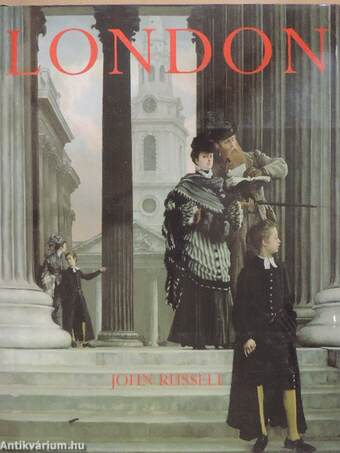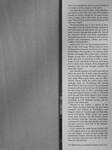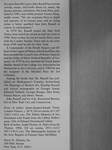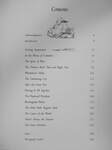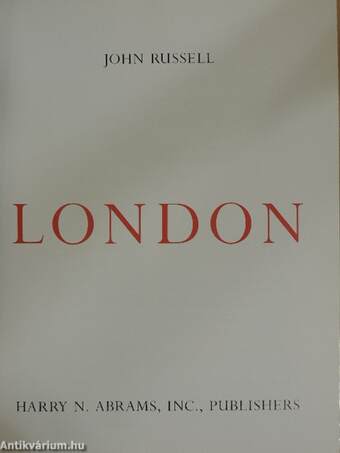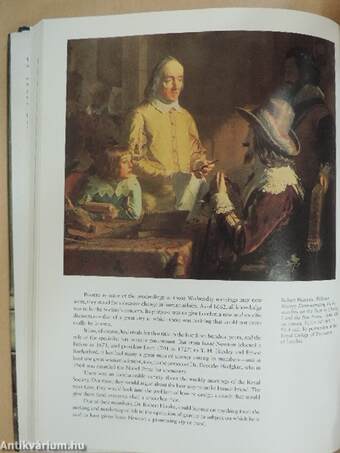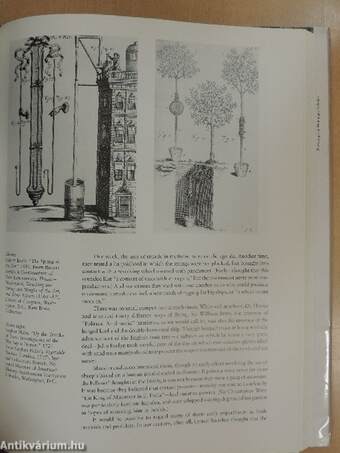1.067.308
kiadvánnyal nyújtjuk Magyarország legnagyobb antikvár könyv-kínálatát

VISSZA
A TETEJÉRE
JAVASLATOKÉszre-
vételek
London
| Kiadó: | Harry N. Abrams, Inc., Publishers |
|---|---|
| Kiadás helye: | New York |
| Kiadás éve: | |
| Kötés típusa: | Vászon |
| Oldalszám: | 256 oldal |
| Sorozatcím: | |
| Kötetszám: | |
| Nyelv: | Angol |
| Méret: | 30 cm x 23 cm |
| ISBN: | 0-8109-3570-8 |
| Megjegyzés: | Színes és fekete-fehér fotókkal, reprodukciókkal. További kapcsolódó személyek a kötetben. |
naponta értesítjük a beérkező friss
kiadványokról
naponta értesítjük a beérkező friss
kiadványokról
Fülszöveg
This is not a guidebook. Nor is it a travel book. It is a book in which memory is the motor.
It is about the city of London, where John Rus-sell lived for somé fifty years and still considers himself an insider, though he has spent twenty years in happy exile in New York. As the author says, "I have tried to set down what I once saw and will ne ver forget."
Notwithstanding one or two slivers of auto-biography, the book is about the huge company of men and women through whom one can come to know London. Among these people, Mr. Russell has recruited divines and divas, philosophers and parliamentarians, economists and essayists, painters and printmakers, cabbies and cooks, bankers and booksellers.
Each in their own way, these people made London in their own image. Where would we be in thinking about this great and diverse city without Sámuel Pepys, for example, or Dr. Johnson, John Donne, Christopher Wren, John Soane, the Prince Regent, George Eliot, or Edward Elgar?... Tovább
Fülszöveg
This is not a guidebook. Nor is it a travel book. It is a book in which memory is the motor.
It is about the city of London, where John Rus-sell lived for somé fifty years and still considers himself an insider, though he has spent twenty years in happy exile in New York. As the author says, "I have tried to set down what I once saw and will ne ver forget."
Notwithstanding one or two slivers of auto-biography, the book is about the huge company of men and women through whom one can come to know London. Among these people, Mr. Russell has recruited divines and divas, philosophers and parliamentarians, economists and essayists, painters and printmakers, cabbies and cooks, bankers and booksellers.
Each in their own way, these people made London in their own image. Where would we be in thinking about this great and diverse city without Sámuel Pepys, for example, or Dr. Johnson, John Donne, Christopher Wren, John Soane, the Prince Regent, George Eliot, or Edward Elgar? Collec-tively, they gave us something to look at, some-thing to read, something to listen to, and a great deal to think about. Despite all the changes and upheavals that time has wrought, London still bears their stamp.
John Russell's memoir of London goes back to before the great fire of 1666, when the modern city was förmed. It looks inside St. Paul's Cathe-dral, under Wren's great dome, and into Westminster Abbey, where the author spent many midnight hours on fire-fighting duty during World War II and came to know the monuments lining the walls as well as he knew the furniture in his own living room. It offers a privileged peek inside Buckingham Palace as well as a leisurely stroll through John Nash's Regent's Park. It lives through great days in the House of Commons, eavesdrops at Lady Holland's soirées, and ap-plauds a new Pintér play.
Selected by the author, a gallery of the city's finest recorders illustrates the text, from Canaletto and Zoffany to Rowlandson and Hogarth. Here are Gainsborough and Reynolds, Turner and Monet, Walter Sickert and Lucián Freud, John Thomson and Bili Brandt. Nearly two hundred paintings, drawings, watercolors, architectural renderings, photographs, cartoons, and more serve as visual foils to Mr. Russell's verbal recollections.
In all, whether the reader knows London well or only slightly, there is so much here of percep-tion and delight, so much of fresh insight and remembered moment, that the city seen through this articulate observer's eyes will feel at once both new and familiar.
183 illustrations, including 86 plates in full color
For more than fifty years, John Russell has written articles, essays, and books about art, music, the theater, persons, and places. His book Paris, pub-lished in 1983, was widely praised. Francis Steeg-muller wrote, "No city surpasses Paris in depth and intensity of its humán past; and no living writer is better qualified than John Russell to convey its enchantment."
In 1974 Mr. Russell joined the New York Times, from which he retired as chief art critic in 1990. Prior to that, he was for nearly thirty years with the London Sunday Times and its art critic from 1949 until he left for New York.
A Commander of the British Empire and Of-ficier of the Légion of Honor, John Russell has alsó been awarded the Grand Cross of Honor (Austria) and the Order of Merit (Federal Republic of Ger-many). In 1979 he was awarded the Frank Jewett Mather Award of the College Art Association for Distinction in Art Criticism, and in 1984 he was the recipient of the Mitchell Prize for Art Criticism.
Among the books that Mr. Russell has pub-lished are Sbakespeare's Country, Switzerland, The Meanings of Modern Art, Reading Russell, and critical monographs on Georges Seurat, Edouard Vuillard, Georges Braque, Max Ernst, Francis Bacon, and Henry Moore.
John Russell and his wife, Rosamond Bernier, live in New York City and Connecticut.
Front of jacket: James-Jacques-Joseph Tissot. London Visitors. c. 1874. Oil on canvas, 63 x 45" (160 X 114.2 cm). The Toledo Museum of Art, Purchased with Funds from the Libbey Endow-ment. Gift of Edward Drummond Libbey Back of jacket: André Derain. St. Paul's from the Thames. 1906. Oil on canvas, 39%x32W (99.7x81.9 cm). The Minneapolis Institute of the Arts. Bequest of Putnam Dana McMillan
Harry N. Abrams, Inc. 100 Fifth Avenue New York, N.Y. 10011
Vissza
Témakörök
- Idegennyelv > Idegennyelvű könyvek > Angol > Művészetek > Építészet
- Idegennyelv > Idegennyelvű könyvek > Angol > Művelődéstörténet
- Idegennyelv > Idegennyelvű könyvek > Angol > Helytörténet
- Művelődéstörténet > Kultúra > Története
- Helytörténet > Külföldi > Városok
- Helytörténet > Helyismeret > Várak, építmények
- Művészetek > Építészet > Várostörténet > Külföldi
- Művészetek > Építészet > Kontinensek szerint > Európa > Angol
- Művészetek > Építészet > Idegen nyelv > Angol
- Művészetek > Építészet > Műemlékek > Egyéb
John Russell
John Russell műveinek az Antikvarium.hu-n kapható vagy előjegyezhető listáját itt tekintheti meg: John Russell könyvek, művekMegvásárolható példányok
Nincs megvásárolható példány
A könyv összes megrendelhető példánya elfogyott. Ha kívánja, előjegyezheti a könyvet, és amint a könyv egy újabb példánya elérhető lesz, értesítjük.



